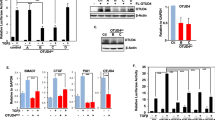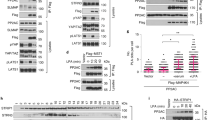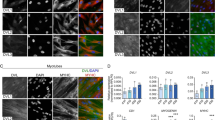Abstract
TRANSFORMING growth factor-β TGF-β is the prototype for a family of extracellular proteins that affect cell proliferation and tissue differentiation1–3. TGF-β-related factors, including BMP-2/4, Dpp and activin, act through two types of serine/threonine kinase receptors which can form a heteromeric complex3,4. However, the mechanism of signal transduction by these receptors is largely unknown. In Drosophila, Mad is required for signalling by Dpp5. We have isolated complementary DNAs for four human Mad homologues, one of which, hMAD-4, is identical to DPC-4, a candidate tumour suppressor6. hMAD-3 and -4 synergized to induce strong ligand-independent TGF-β-like responses. When truncated at their carboxy termini, hMAD-3 and -4 act as dominant-negative inhibitors of the normal TGF-β response. The activity of hMAD-3 and -4 was regulated by the TGF-β receptors, and hMAD-3 but not hMAD-4 was phosphorylated and associated with the ligand-bound receptor complex. These results define hMAD-3 and -4 as effectors of the TGF-β response and demonstrate a function for DPC-4/hMAD-4 as a tumour suppressor.
This is a preview of subscription content, access via your institution
Access options
Subscribe to this journal
Receive 51 print issues and online access
$199.00 per year
only $3.90 per issue
Buy this article
- Purchase on Springer Link
- Instant access to full article PDF
Prices may be subject to local taxes which are calculated during checkout
Similar content being viewed by others
References
Derynck, R. in The Cytokine Handbook (ed. Thomson, A. W.) 319–342 (Academic, San Diego, 1994).
Kingsley, D. M. Genes Dev. 8, 133–146 (1994).
Massagué, J., Attisano, L. & Wrana, J. L. Trends Cell Biol. 4, 172–177 (1994).
Derynck, R. Trends Biochem. Sci. 19, 548–553 (1994).
Sekelsky, J. J., Newfeld, S. J., Raftery, L. A., Chartoff, E. H. & Gelbart, W. M. Genetics 139, 1347–1358 (1995).
Hahn, S. A. et al. Science 271, 350–353 (1996).
Hoodless, P. A. et al. Cell 85, 489–500 (1996).
Graff, J. M., Bansal, A. & Melton, D. A. Cell 85, 479–487 (1996).
Abe, M. et al. Anal. Biochem. 216, 276–284 (1994).
Goyette, M. C. et al. Mol. Cell. Biol. 12, 1387–1395 (1994).
Wrana, J. L. et al. Cell 71, 1003–1014 (1992).
Weis-Garcia, F. & Massagué, J. EMBO J. 15, 276–289 (1996).
Feng, X.-H., Filvaroff, E. H. & Derynck, R. J. Biol. Chem. 270, 24237–24245 (1995).
Matzuk, M. M. & Bradley, A. Biochim. Biophys. Acta 1130, 105–108 (1992) (erratum, 243).
Ebner, R. et al. Science 260, 1344–1348 (1993).
Gyuris, J., Golemis, E., Chertkov, H. & Brent, R. Cell 75, 791–803 (1993).
Liu, F. et al. Nature 381, 620–623 (1996).
Ihle, J. Nature 377, 591–594 (1995).
Arora, K. et al. Cell 81, 781–790 (1995).
Grieder, N. C., Nellen, D., Burke, R., Basler, K. & Affolter, M. Cell 81, 791–800 (1995).
de Celis, J. F., Barrio, R. & Kafatos, F. C. Nature 381, 421–424 (1996).
Markowitz, S. et al. Science 268, 1336–1338 (1995).
Laiho, M., DeCaprio, J. A., Ludlow, J. W. & Livingston, D. M. Cell 62, 175–185 (1990).
Lennon, G. G., Auffray, C., Polymeropoulos, M. & Soares, M. B. Genomics 33, 151–152 (1996).
Chen, R.-H., Miettinen, P. J., Maruoka, E. M., Choy, L. & Derynck, R. Nature 377, 548–552 (1995).
Lin, H. Y., Wang, X.-F., Ng-Eaton, E., Weinberg, R. A. & Lodish, H. F. Cell 68, 775–785 (1992).
Keeton, M. R., Curriden, S. A., van Zonneveld, A. & Loskutoff, D. J. J. Biol. Chem. 266, 23048–23052 (1991).
Like, B. & Massagué, J. J. Biol. Chem. 261, 13426–13429 (1986).
Smith, D. B. & Johnson, K. S. Gene 67, 31–40 (1990).
Eppert, K. et al. Cell 86, 543–552 (1996).
Riggin, G. J. et al. Nature Genet. 13, 347–349 (1996).
Baker, J. C. & Harland, R. M. Genes Dev. 10 1880–1889 (1996).
Author information
Authors and Affiliations
Rights and permissions
About this article
Cite this article
Zhang, Y., Feng, XH., Wu, RY. et al. Receptor-associated Mad homologues synergize as effectors of the TGF-β response. Nature 383, 168–172 (1996). https://doi.org/10.1038/383168a0
Received:
Accepted:
Issue Date:
DOI: https://doi.org/10.1038/383168a0
This article is cited by
-
Genetic alterations shape innate immune cells to foster immunosuppression and cancer immunotherapy resistance
Clinical and Experimental Medicine (2023)
-
Short telomeres impede germ cell specification by upregulating MAPK and TGFβ signaling
Science China Life Sciences (2023)
-
BMP2 promotes lung adenocarcinoma metastasis through BMP receptor 2-mediated SMAD1/5 activation
Scientific Reports (2022)
-
The role of Smad6 in immunity of the pearl oyster Pinctada fucata martensii
Journal of Oceanology and Limnology (2022)
-
BMP3 is a novel locus involved in the causality of ocular coloboma
Human Genetics (2022)
Comments
By submitting a comment you agree to abide by our Terms and Community Guidelines. If you find something abusive or that does not comply with our terms or guidelines please flag it as inappropriate.



